Cross-Cultural Adaptation: South Korean and Indian Students in America
VerifiedAdded on 2023/03/21
|30
|9039
|73
Capstone Project
AI Summary
This capstone project examines the cultural adaptation challenges experienced by South Korean and Indian students studying in the United States, utilizing the Hofstede model to analyze cultural differences. It highlights the increasing number of Asian students pursuing higher education abroad, with the US being a primary destination. The project focuses on the cultural shocks and challenges faced by students from South Korea and India, including issues related to power distance, individualism, indulgence, and collectivism. It explores how these cultural differences impact academic performance, social integration, and mental well-being. The study also touches upon initiatives taken by students to overcome these challenges, aiming to provide insights into fostering better cross-cultural understanding and support for international students. Additionally, an annotated bibliography on mental health problems and societal responses provides relevant context.

Running head: CAPSTONE PROJECT
Cross examination of both cultures of South Korea and Indian international students and how
they adapt to outside cultures
Name of the Student
Name of the University
Author Note
Cross examination of both cultures of South Korea and Indian international students and how
they adapt to outside cultures
Name of the Student
Name of the University
Author Note
Paraphrase This Document
Need a fresh take? Get an instant paraphrase of this document with our AI Paraphraser
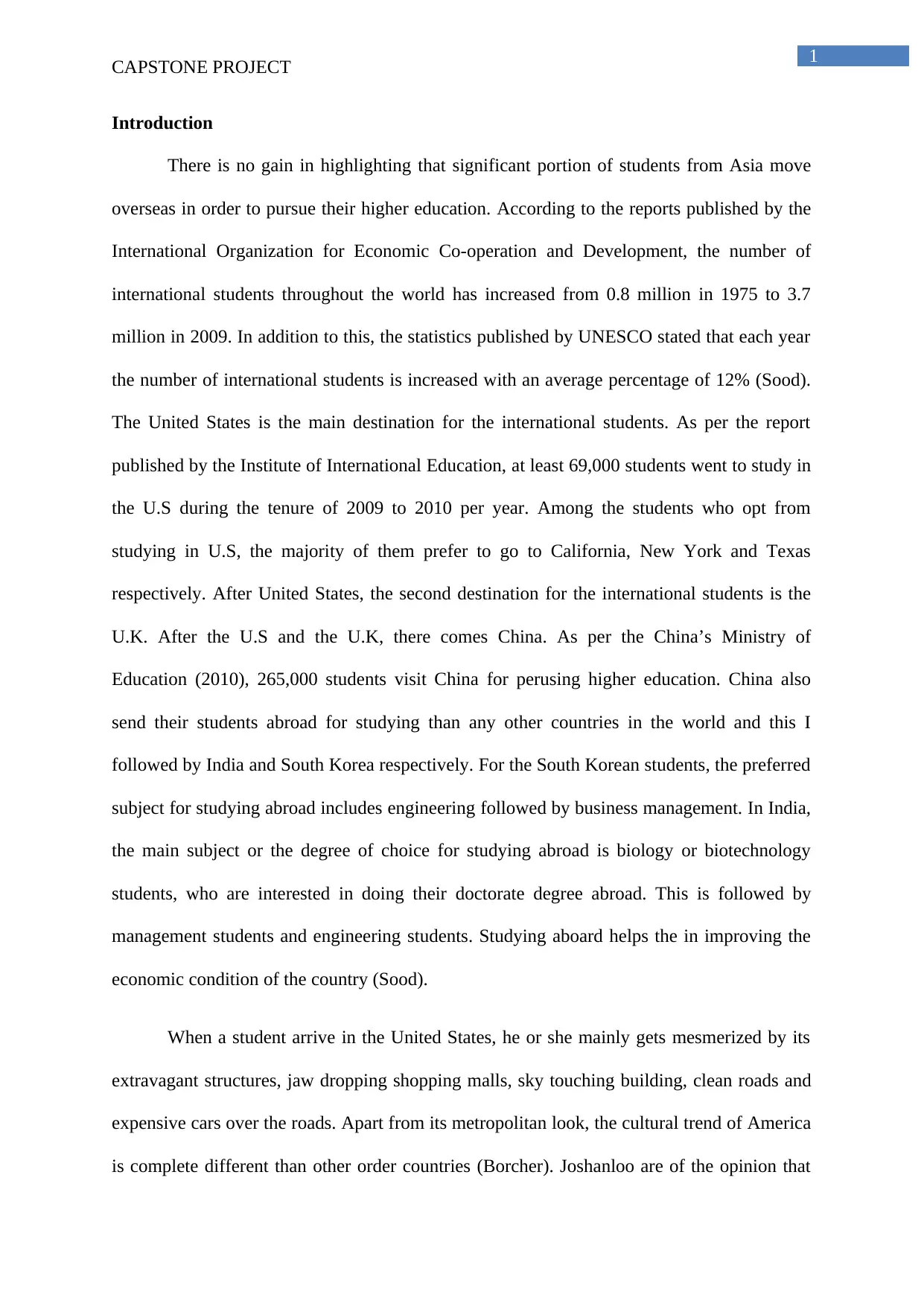
1
CAPSTONE PROJECT
Introduction
There is no gain in highlighting that significant portion of students from Asia move
overseas in order to pursue their higher education. According to the reports published by the
International Organization for Economic Co-operation and Development, the number of
international students throughout the world has increased from 0.8 million in 1975 to 3.7
million in 2009. In addition to this, the statistics published by UNESCO stated that each year
the number of international students is increased with an average percentage of 12% (Sood).
The United States is the main destination for the international students. As per the report
published by the Institute of International Education, at least 69,000 students went to study in
the U.S during the tenure of 2009 to 2010 per year. Among the students who opt from
studying in U.S, the majority of them prefer to go to California, New York and Texas
respectively. After United States, the second destination for the international students is the
U.K. After the U.S and the U.K, there comes China. As per the China’s Ministry of
Education (2010), 265,000 students visit China for perusing higher education. China also
send their students abroad for studying than any other countries in the world and this I
followed by India and South Korea respectively. For the South Korean students, the preferred
subject for studying abroad includes engineering followed by business management. In India,
the main subject or the degree of choice for studying abroad is biology or biotechnology
students, who are interested in doing their doctorate degree abroad. This is followed by
management students and engineering students. Studying aboard helps the in improving the
economic condition of the country (Sood).
When a student arrive in the United States, he or she mainly gets mesmerized by its
extravagant structures, jaw dropping shopping malls, sky touching building, clean roads and
expensive cars over the roads. Apart from its metropolitan look, the cultural trend of America
is complete different than other order countries (Borcher). Joshanloo are of the opinion that
CAPSTONE PROJECT
Introduction
There is no gain in highlighting that significant portion of students from Asia move
overseas in order to pursue their higher education. According to the reports published by the
International Organization for Economic Co-operation and Development, the number of
international students throughout the world has increased from 0.8 million in 1975 to 3.7
million in 2009. In addition to this, the statistics published by UNESCO stated that each year
the number of international students is increased with an average percentage of 12% (Sood).
The United States is the main destination for the international students. As per the report
published by the Institute of International Education, at least 69,000 students went to study in
the U.S during the tenure of 2009 to 2010 per year. Among the students who opt from
studying in U.S, the majority of them prefer to go to California, New York and Texas
respectively. After United States, the second destination for the international students is the
U.K. After the U.S and the U.K, there comes China. As per the China’s Ministry of
Education (2010), 265,000 students visit China for perusing higher education. China also
send their students abroad for studying than any other countries in the world and this I
followed by India and South Korea respectively. For the South Korean students, the preferred
subject for studying abroad includes engineering followed by business management. In India,
the main subject or the degree of choice for studying abroad is biology or biotechnology
students, who are interested in doing their doctorate degree abroad. This is followed by
management students and engineering students. Studying aboard helps the in improving the
economic condition of the country (Sood).
When a student arrive in the United States, he or she mainly gets mesmerized by its
extravagant structures, jaw dropping shopping malls, sky touching building, clean roads and
expensive cars over the roads. Apart from its metropolitan look, the cultural trend of America
is complete different than other order countries (Borcher). Joshanloo are of the opinion that
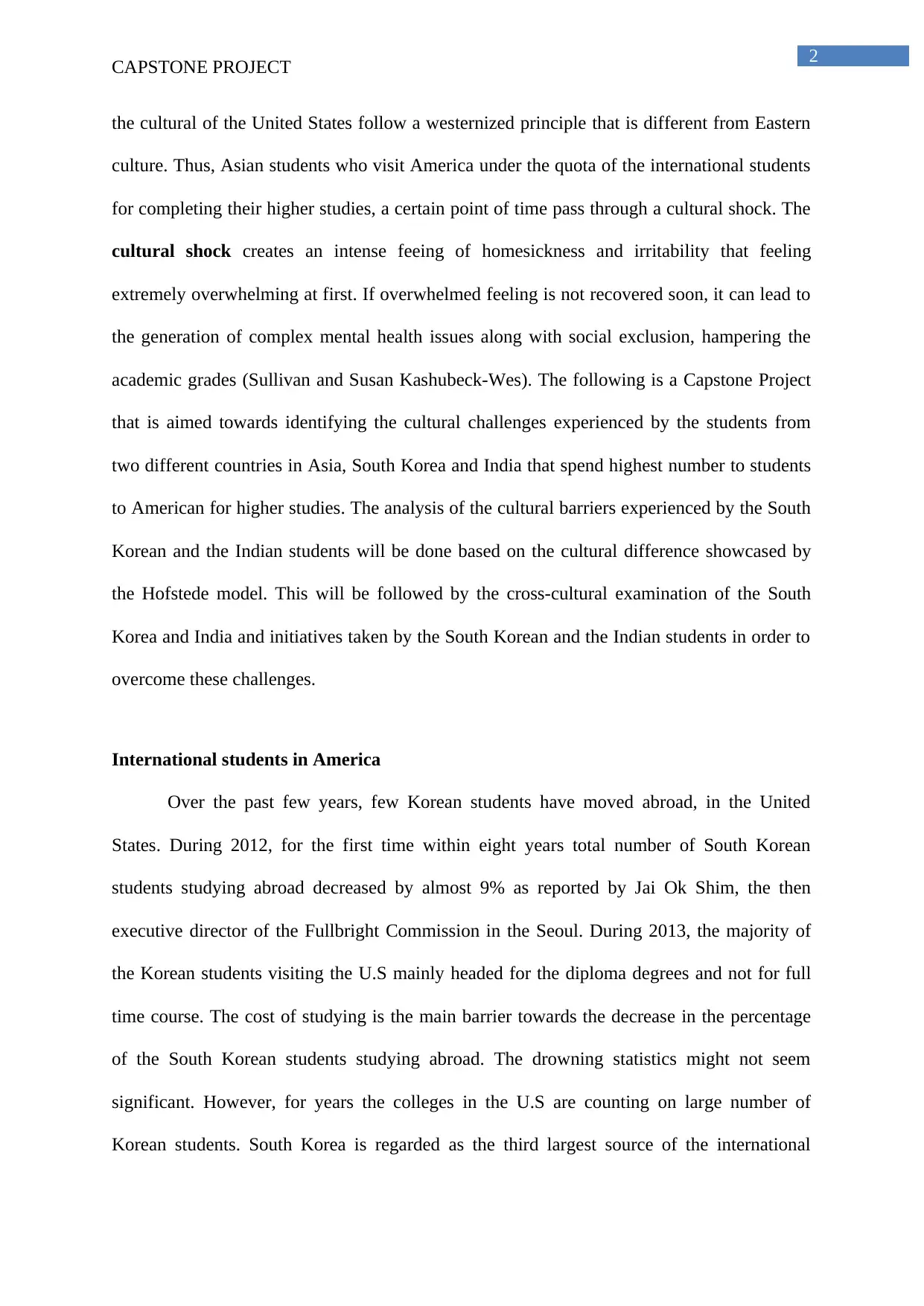
2
CAPSTONE PROJECT
the cultural of the United States follow a westernized principle that is different from Eastern
culture. Thus, Asian students who visit America under the quota of the international students
for completing their higher studies, a certain point of time pass through a cultural shock. The
cultural shock creates an intense feeing of homesickness and irritability that feeling
extremely overwhelming at first. If overwhelmed feeling is not recovered soon, it can lead to
the generation of complex mental health issues along with social exclusion, hampering the
academic grades (Sullivan and Susan Kashubeck-Wes). The following is a Capstone Project
that is aimed towards identifying the cultural challenges experienced by the students from
two different countries in Asia, South Korea and India that spend highest number to students
to American for higher studies. The analysis of the cultural barriers experienced by the South
Korean and the Indian students will be done based on the cultural difference showcased by
the Hofstede model. This will be followed by the cross-cultural examination of the South
Korea and India and initiatives taken by the South Korean and the Indian students in order to
overcome these challenges.
International students in America
Over the past few years, few Korean students have moved abroad, in the United
States. During 2012, for the first time within eight years total number of South Korean
students studying abroad decreased by almost 9% as reported by Jai Ok Shim, the then
executive director of the Fullbright Commission in the Seoul. During 2013, the majority of
the Korean students visiting the U.S mainly headed for the diploma degrees and not for full
time course. The cost of studying is the main barrier towards the decrease in the percentage
of the South Korean students studying abroad. The drowning statistics might not seem
significant. However, for years the colleges in the U.S are counting on large number of
Korean students. South Korea is regarded as the third largest source of the international
CAPSTONE PROJECT
the cultural of the United States follow a westernized principle that is different from Eastern
culture. Thus, Asian students who visit America under the quota of the international students
for completing their higher studies, a certain point of time pass through a cultural shock. The
cultural shock creates an intense feeing of homesickness and irritability that feeling
extremely overwhelming at first. If overwhelmed feeling is not recovered soon, it can lead to
the generation of complex mental health issues along with social exclusion, hampering the
academic grades (Sullivan and Susan Kashubeck-Wes). The following is a Capstone Project
that is aimed towards identifying the cultural challenges experienced by the students from
two different countries in Asia, South Korea and India that spend highest number to students
to American for higher studies. The analysis of the cultural barriers experienced by the South
Korean and the Indian students will be done based on the cultural difference showcased by
the Hofstede model. This will be followed by the cross-cultural examination of the South
Korea and India and initiatives taken by the South Korean and the Indian students in order to
overcome these challenges.
International students in America
Over the past few years, few Korean students have moved abroad, in the United
States. During 2012, for the first time within eight years total number of South Korean
students studying abroad decreased by almost 9% as reported by Jai Ok Shim, the then
executive director of the Fullbright Commission in the Seoul. During 2013, the majority of
the Korean students visiting the U.S mainly headed for the diploma degrees and not for full
time course. The cost of studying is the main barrier towards the decrease in the percentage
of the South Korean students studying abroad. The drowning statistics might not seem
significant. However, for years the colleges in the U.S are counting on large number of
Korean students. South Korea is regarded as the third largest source of the international
⊘ This is a preview!⊘
Do you want full access?
Subscribe today to unlock all pages.

Trusted by 1+ million students worldwide
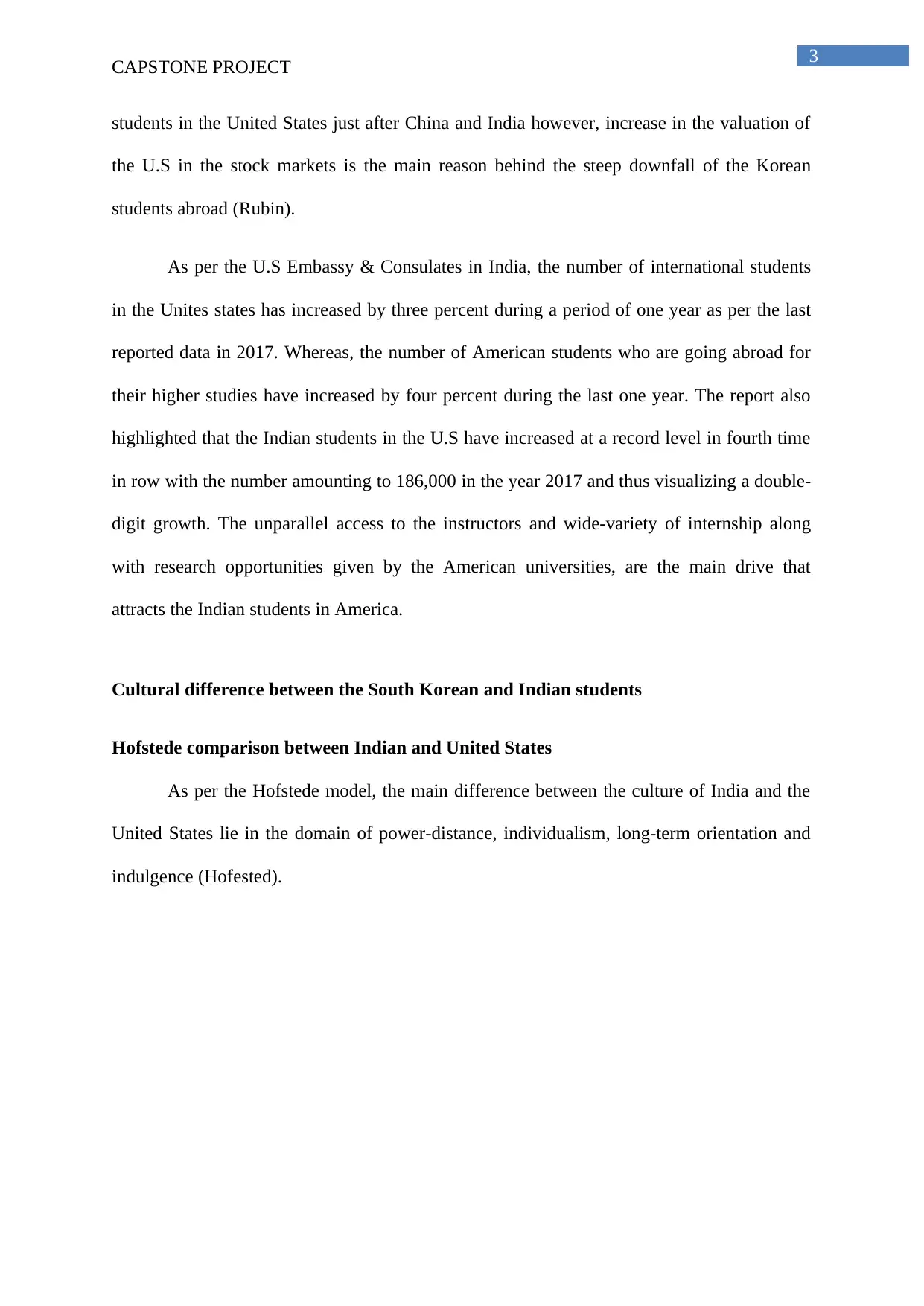
3
CAPSTONE PROJECT
students in the United States just after China and India however, increase in the valuation of
the U.S in the stock markets is the main reason behind the steep downfall of the Korean
students abroad (Rubin).
As per the U.S Embassy & Consulates in India, the number of international students
in the Unites states has increased by three percent during a period of one year as per the last
reported data in 2017. Whereas, the number of American students who are going abroad for
their higher studies have increased by four percent during the last one year. The report also
highlighted that the Indian students in the U.S have increased at a record level in fourth time
in row with the number amounting to 186,000 in the year 2017 and thus visualizing a double-
digit growth. The unparallel access to the instructors and wide-variety of internship along
with research opportunities given by the American universities, are the main drive that
attracts the Indian students in America.
Cultural difference between the South Korean and Indian students
Hofstede comparison between Indian and United States
As per the Hofstede model, the main difference between the culture of India and the
United States lie in the domain of power-distance, individualism, long-term orientation and
indulgence (Hofested).
CAPSTONE PROJECT
students in the United States just after China and India however, increase in the valuation of
the U.S in the stock markets is the main reason behind the steep downfall of the Korean
students abroad (Rubin).
As per the U.S Embassy & Consulates in India, the number of international students
in the Unites states has increased by three percent during a period of one year as per the last
reported data in 2017. Whereas, the number of American students who are going abroad for
their higher studies have increased by four percent during the last one year. The report also
highlighted that the Indian students in the U.S have increased at a record level in fourth time
in row with the number amounting to 186,000 in the year 2017 and thus visualizing a double-
digit growth. The unparallel access to the instructors and wide-variety of internship along
with research opportunities given by the American universities, are the main drive that
attracts the Indian students in America.
Cultural difference between the South Korean and Indian students
Hofstede comparison between Indian and United States
As per the Hofstede model, the main difference between the culture of India and the
United States lie in the domain of power-distance, individualism, long-term orientation and
indulgence (Hofested).
Paraphrase This Document
Need a fresh take? Get an instant paraphrase of this document with our AI Paraphraser

4
CAPSTONE PROJECT
Figure: Hosftede comparison between the India and the United States
(Source: Hofstede Insight)
The dimension of power-distance in Hofstede model highlights that fact that not all
the individuals in the societies are equal. It mainly expresses the attitude of the culture
towards the inequalities prevalent in the societies. India scores high in power distance (77) in
comparison to the United States (40) (Hofested). This difference in the power dimension in
the Indian and American culture generates a tendency among the Indian students to develop
an attitude to being dominated or directed by others. The Indian students are more likely to
expect to be directed by the teachers or the seniors than taking their own decisions unlike the
native students of America. This creates a barrier in their academic success, as they believe
that it is the duty of the teachers to make the determining decisions for them. In the academic
field for higher studies in America, encouragement is given for independent thinking like
writing a new research proposal or designing a new project in an independent manner. Since
the Indian students loves to be directed by the professors’ they lack in the ground of
independent thinking and problem solving skills and thereby creating a gap in quality
CAPSTONE PROJECT
Figure: Hosftede comparison between the India and the United States
(Source: Hofstede Insight)
The dimension of power-distance in Hofstede model highlights that fact that not all
the individuals in the societies are equal. It mainly expresses the attitude of the culture
towards the inequalities prevalent in the societies. India scores high in power distance (77) in
comparison to the United States (40) (Hofested). This difference in the power dimension in
the Indian and American culture generates a tendency among the Indian students to develop
an attitude to being dominated or directed by others. The Indian students are more likely to
expect to be directed by the teachers or the seniors than taking their own decisions unlike the
native students of America. This creates a barrier in their academic success, as they believe
that it is the duty of the teachers to make the determining decisions for them. In the academic
field for higher studies in America, encouragement is given for independent thinking like
writing a new research proposal or designing a new project in an independent manner. Since
the Indian students loves to be directed by the professors’ they lack in the ground of
independent thinking and problem solving skills and thereby creating a gap in quality
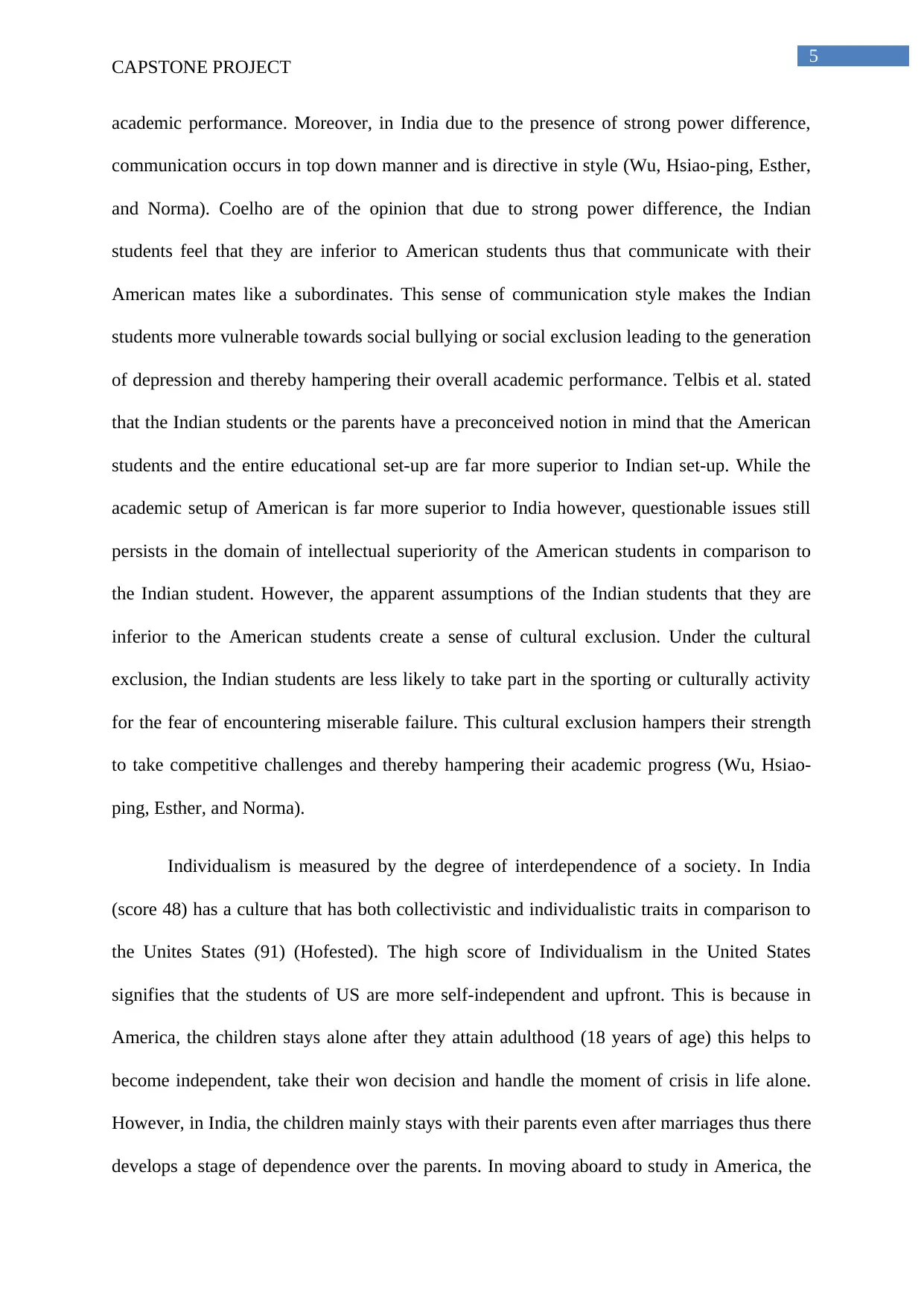
5
CAPSTONE PROJECT
academic performance. Moreover, in India due to the presence of strong power difference,
communication occurs in top down manner and is directive in style (Wu, Hsiao-ping, Esther,
and Norma). Coelho are of the opinion that due to strong power difference, the Indian
students feel that they are inferior to American students thus that communicate with their
American mates like a subordinates. This sense of communication style makes the Indian
students more vulnerable towards social bullying or social exclusion leading to the generation
of depression and thereby hampering their overall academic performance. Telbis et al. stated
that the Indian students or the parents have a preconceived notion in mind that the American
students and the entire educational set-up are far more superior to Indian set-up. While the
academic setup of American is far more superior to India however, questionable issues still
persists in the domain of intellectual superiority of the American students in comparison to
the Indian student. However, the apparent assumptions of the Indian students that they are
inferior to the American students create a sense of cultural exclusion. Under the cultural
exclusion, the Indian students are less likely to take part in the sporting or culturally activity
for the fear of encountering miserable failure. This cultural exclusion hampers their strength
to take competitive challenges and thereby hampering their academic progress (Wu, Hsiao-
ping, Esther, and Norma).
Individualism is measured by the degree of interdependence of a society. In India
(score 48) has a culture that has both collectivistic and individualistic traits in comparison to
the Unites States (91) (Hofested). The high score of Individualism in the United States
signifies that the students of US are more self-independent and upfront. This is because in
America, the children stays alone after they attain adulthood (18 years of age) this helps to
become independent, take their won decision and handle the moment of crisis in life alone.
However, in India, the children mainly stays with their parents even after marriages thus there
develops a stage of dependence over the parents. In moving aboard to study in America, the
CAPSTONE PROJECT
academic performance. Moreover, in India due to the presence of strong power difference,
communication occurs in top down manner and is directive in style (Wu, Hsiao-ping, Esther,
and Norma). Coelho are of the opinion that due to strong power difference, the Indian
students feel that they are inferior to American students thus that communicate with their
American mates like a subordinates. This sense of communication style makes the Indian
students more vulnerable towards social bullying or social exclusion leading to the generation
of depression and thereby hampering their overall academic performance. Telbis et al. stated
that the Indian students or the parents have a preconceived notion in mind that the American
students and the entire educational set-up are far more superior to Indian set-up. While the
academic setup of American is far more superior to India however, questionable issues still
persists in the domain of intellectual superiority of the American students in comparison to
the Indian student. However, the apparent assumptions of the Indian students that they are
inferior to the American students create a sense of cultural exclusion. Under the cultural
exclusion, the Indian students are less likely to take part in the sporting or culturally activity
for the fear of encountering miserable failure. This cultural exclusion hampers their strength
to take competitive challenges and thereby hampering their academic progress (Wu, Hsiao-
ping, Esther, and Norma).
Individualism is measured by the degree of interdependence of a society. In India
(score 48) has a culture that has both collectivistic and individualistic traits in comparison to
the Unites States (91) (Hofested). The high score of Individualism in the United States
signifies that the students of US are more self-independent and upfront. This is because in
America, the children stays alone after they attain adulthood (18 years of age) this helps to
become independent, take their won decision and handle the moment of crisis in life alone.
However, in India, the children mainly stays with their parents even after marriages thus there
develops a stage of dependence over the parents. In moving aboard to study in America, the
⊘ This is a preview!⊘
Do you want full access?
Subscribe today to unlock all pages.

Trusted by 1+ million students worldwide

6
CAPSTONE PROJECT
Indian students feel felt out or become home sick and this promote the development of
depression, hampering the overall academic performance (Embree).
In the domain of indulgence, India scores 26 and that of the United States scores 96.
Indulgence signifies that the degree or the extent at which a race of a particular culture try of
control their impulses or desires (Hofested). The Indian Society believes in restrain and life
after death such that they do not put emphasis on leisure time and have a tendency to control
gratification of their desires. Among the American students, there is a prevalence of prom
nights or partying during the weekends. According to Haq taking a break from the hectic
schedules of work or study during the weekends act as a source of mental refreshment and
this in turn helps the students to perform better in academic. However, students from India
are not comfortable in taking active part in prom night because of their restraint behavior.
This creates a barrier in developing new friends within the college or university premises and
at the same time increases their level of academic stress.
Hofstede comparison between South Korea and United States
As per the Hofstede model, the difference between the culture of South Korea and
United States is reflected in all parameters of power-distance, individualism, masculinity,
long-term orientation and indulgence (Hofested).
CAPSTONE PROJECT
Indian students feel felt out or become home sick and this promote the development of
depression, hampering the overall academic performance (Embree).
In the domain of indulgence, India scores 26 and that of the United States scores 96.
Indulgence signifies that the degree or the extent at which a race of a particular culture try of
control their impulses or desires (Hofested). The Indian Society believes in restrain and life
after death such that they do not put emphasis on leisure time and have a tendency to control
gratification of their desires. Among the American students, there is a prevalence of prom
nights or partying during the weekends. According to Haq taking a break from the hectic
schedules of work or study during the weekends act as a source of mental refreshment and
this in turn helps the students to perform better in academic. However, students from India
are not comfortable in taking active part in prom night because of their restraint behavior.
This creates a barrier in developing new friends within the college or university premises and
at the same time increases their level of academic stress.
Hofstede comparison between South Korea and United States
As per the Hofstede model, the difference between the culture of South Korea and
United States is reflected in all parameters of power-distance, individualism, masculinity,
long-term orientation and indulgence (Hofested).
Paraphrase This Document
Need a fresh take? Get an instant paraphrase of this document with our AI Paraphraser

7
CAPSTONE PROJECT
Figure: Hosftede comparison between the South Korea and the United States
(Source: Hofstede Insight)
In the criteria of power distance, it can be said that South Korea follows a strict
hierarchical pattern in the society leading to the generation of inequalities, centralization of
power and controlling the subordinates through benevolent autocrat. This is similar with that
of the Indian culture. Such that the students from South Korea nurture a tendency of being
dominated or being guided by the teachers of the supervisors blindly. This hampers their
creative thinking skills and ability to work independently creating a barrier in their academic
progress. A quasi-experimental study highlighted that the south Korean nursing students in
American prefers traditional medium of learning in comparison to the problem-based
learning and thereby creating a barrier through achieving critical thinking skills and self-
directed learning opportunities (Choi, Ruth and Yeoungsuk). Just like India, South Korea is a
collectivistic society and mainly promotes close long-term commitment. Loyalty is a
paramount of the collectivist culture and mainly over-rides the majority of the societal rules
and other regulations. This is something completely different from the American culture as
CAPSTONE PROJECT
Figure: Hosftede comparison between the South Korea and the United States
(Source: Hofstede Insight)
In the criteria of power distance, it can be said that South Korea follows a strict
hierarchical pattern in the society leading to the generation of inequalities, centralization of
power and controlling the subordinates through benevolent autocrat. This is similar with that
of the Indian culture. Such that the students from South Korea nurture a tendency of being
dominated or being guided by the teachers of the supervisors blindly. This hampers their
creative thinking skills and ability to work independently creating a barrier in their academic
progress. A quasi-experimental study highlighted that the south Korean nursing students in
American prefers traditional medium of learning in comparison to the problem-based
learning and thereby creating a barrier through achieving critical thinking skills and self-
directed learning opportunities (Choi, Ruth and Yeoungsuk). Just like India, South Korea is a
collectivistic society and mainly promotes close long-term commitment. Loyalty is a
paramount of the collectivist culture and mainly over-rides the majority of the societal rules
and other regulations. This is something completely different from the American culture as
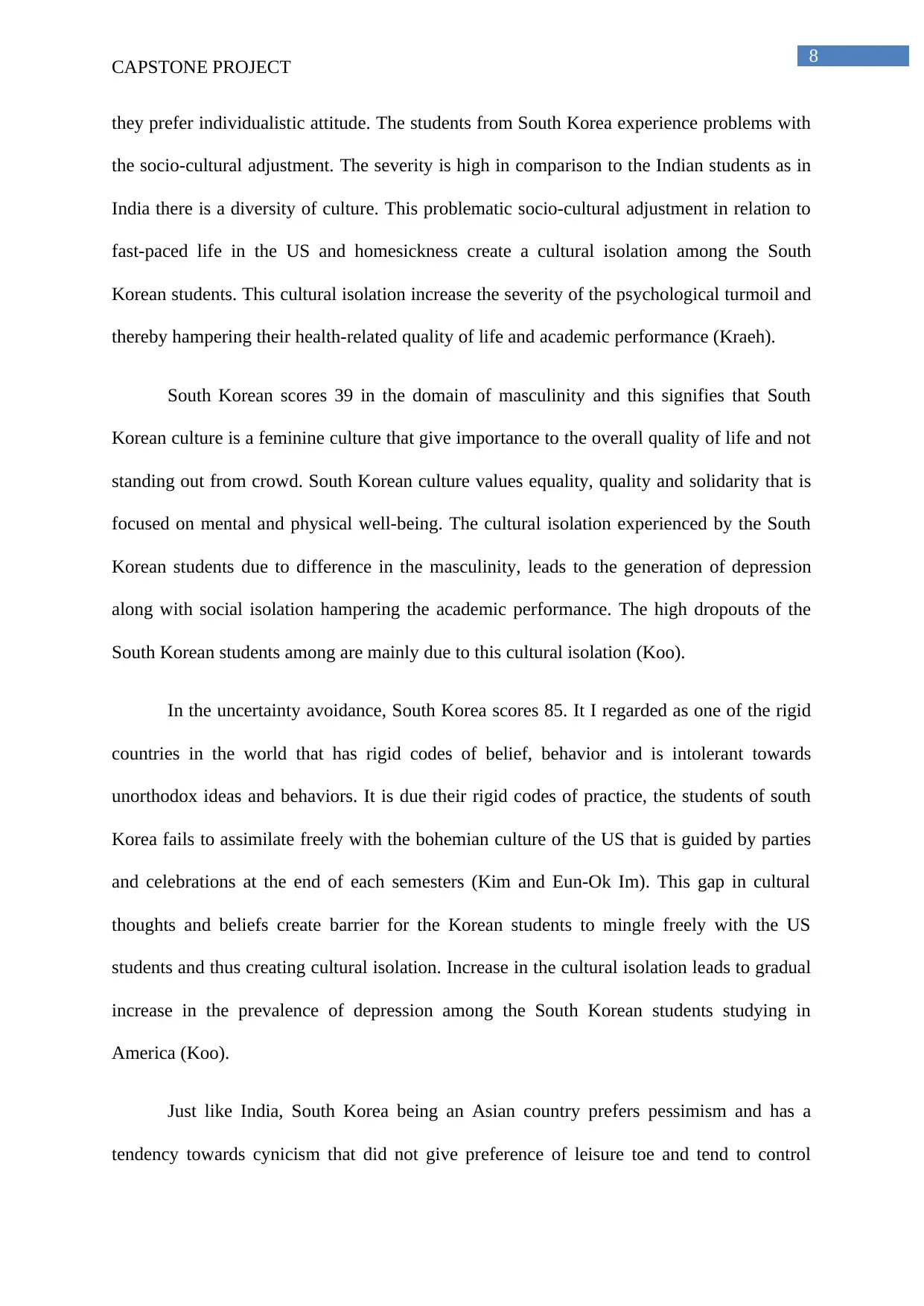
8
CAPSTONE PROJECT
they prefer individualistic attitude. The students from South Korea experience problems with
the socio-cultural adjustment. The severity is high in comparison to the Indian students as in
India there is a diversity of culture. This problematic socio-cultural adjustment in relation to
fast-paced life in the US and homesickness create a cultural isolation among the South
Korean students. This cultural isolation increase the severity of the psychological turmoil and
thereby hampering their health-related quality of life and academic performance (Kraeh).
South Korean scores 39 in the domain of masculinity and this signifies that South
Korean culture is a feminine culture that give importance to the overall quality of life and not
standing out from crowd. South Korean culture values equality, quality and solidarity that is
focused on mental and physical well-being. The cultural isolation experienced by the South
Korean students due to difference in the masculinity, leads to the generation of depression
along with social isolation hampering the academic performance. The high dropouts of the
South Korean students among are mainly due to this cultural isolation (Koo).
In the uncertainty avoidance, South Korea scores 85. It I regarded as one of the rigid
countries in the world that has rigid codes of belief, behavior and is intolerant towards
unorthodox ideas and behaviors. It is due their rigid codes of practice, the students of south
Korea fails to assimilate freely with the bohemian culture of the US that is guided by parties
and celebrations at the end of each semesters (Kim and Eun-Ok Im). This gap in cultural
thoughts and beliefs create barrier for the Korean students to mingle freely with the US
students and thus creating cultural isolation. Increase in the cultural isolation leads to gradual
increase in the prevalence of depression among the South Korean students studying in
America (Koo).
Just like India, South Korea being an Asian country prefers pessimism and has a
tendency towards cynicism that did not give preference of leisure toe and tend to control
CAPSTONE PROJECT
they prefer individualistic attitude. The students from South Korea experience problems with
the socio-cultural adjustment. The severity is high in comparison to the Indian students as in
India there is a diversity of culture. This problematic socio-cultural adjustment in relation to
fast-paced life in the US and homesickness create a cultural isolation among the South
Korean students. This cultural isolation increase the severity of the psychological turmoil and
thereby hampering their health-related quality of life and academic performance (Kraeh).
South Korean scores 39 in the domain of masculinity and this signifies that South
Korean culture is a feminine culture that give importance to the overall quality of life and not
standing out from crowd. South Korean culture values equality, quality and solidarity that is
focused on mental and physical well-being. The cultural isolation experienced by the South
Korean students due to difference in the masculinity, leads to the generation of depression
along with social isolation hampering the academic performance. The high dropouts of the
South Korean students among are mainly due to this cultural isolation (Koo).
In the uncertainty avoidance, South Korea scores 85. It I regarded as one of the rigid
countries in the world that has rigid codes of belief, behavior and is intolerant towards
unorthodox ideas and behaviors. It is due their rigid codes of practice, the students of south
Korea fails to assimilate freely with the bohemian culture of the US that is guided by parties
and celebrations at the end of each semesters (Kim and Eun-Ok Im). This gap in cultural
thoughts and beliefs create barrier for the Korean students to mingle freely with the US
students and thus creating cultural isolation. Increase in the cultural isolation leads to gradual
increase in the prevalence of depression among the South Korean students studying in
America (Koo).
Just like India, South Korea being an Asian country prefers pessimism and has a
tendency towards cynicism that did not give preference of leisure toe and tend to control
⊘ This is a preview!⊘
Do you want full access?
Subscribe today to unlock all pages.

Trusted by 1+ million students worldwide
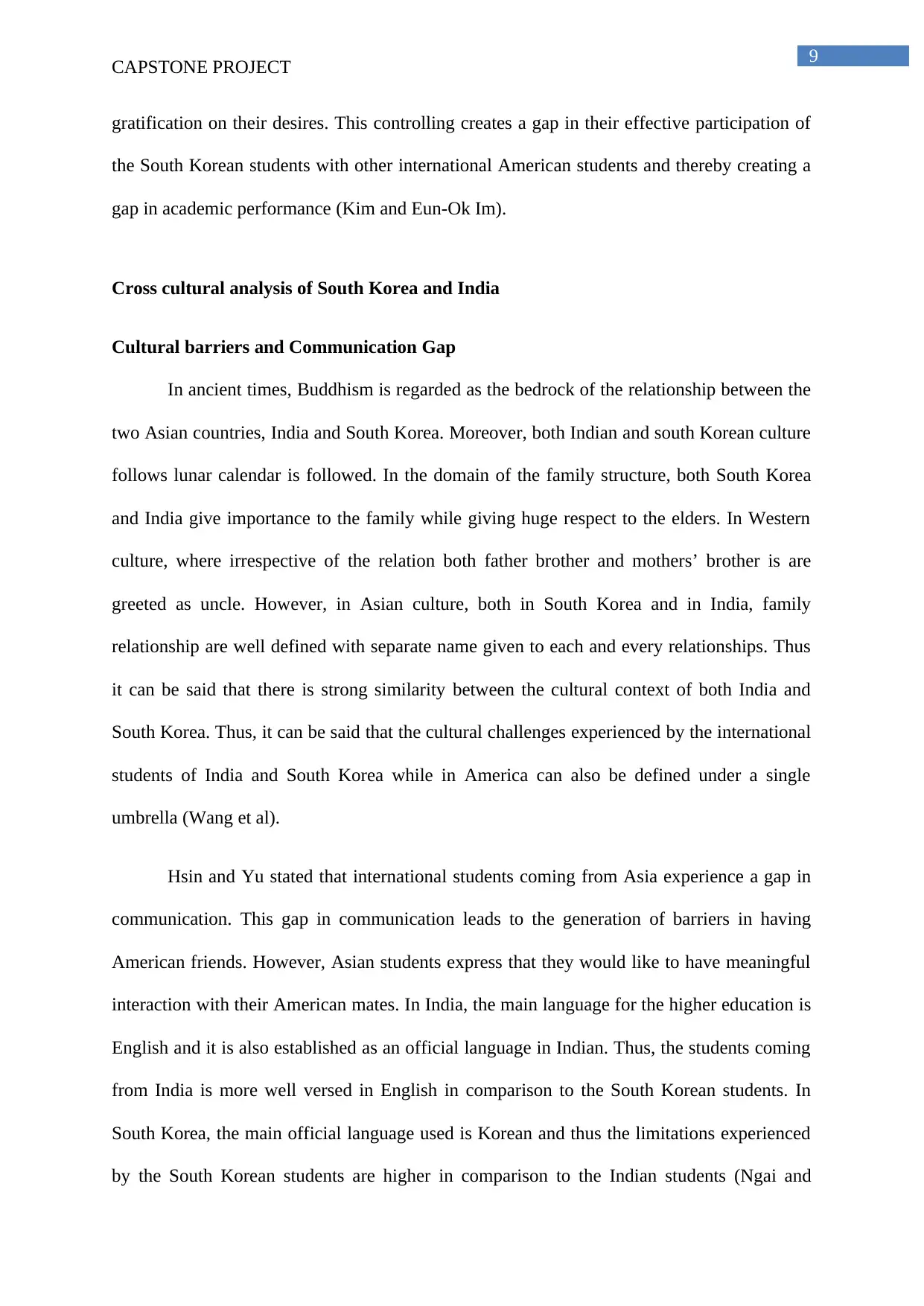
9
CAPSTONE PROJECT
gratification on their desires. This controlling creates a gap in their effective participation of
the South Korean students with other international American students and thereby creating a
gap in academic performance (Kim and Eun-Ok Im).
Cross cultural analysis of South Korea and India
Cultural barriers and Communication Gap
In ancient times, Buddhism is regarded as the bedrock of the relationship between the
two Asian countries, India and South Korea. Moreover, both Indian and south Korean culture
follows lunar calendar is followed. In the domain of the family structure, both South Korea
and India give importance to the family while giving huge respect to the elders. In Western
culture, where irrespective of the relation both father brother and mothers’ brother is are
greeted as uncle. However, in Asian culture, both in South Korea and in India, family
relationship are well defined with separate name given to each and every relationships. Thus
it can be said that there is strong similarity between the cultural context of both India and
South Korea. Thus, it can be said that the cultural challenges experienced by the international
students of India and South Korea while in America can also be defined under a single
umbrella (Wang et al).
Hsin and Yu stated that international students coming from Asia experience a gap in
communication. This gap in communication leads to the generation of barriers in having
American friends. However, Asian students express that they would like to have meaningful
interaction with their American mates. In India, the main language for the higher education is
English and it is also established as an official language in Indian. Thus, the students coming
from India is more well versed in English in comparison to the South Korean students. In
South Korea, the main official language used is Korean and thus the limitations experienced
by the South Korean students are higher in comparison to the Indian students (Ngai and
CAPSTONE PROJECT
gratification on their desires. This controlling creates a gap in their effective participation of
the South Korean students with other international American students and thereby creating a
gap in academic performance (Kim and Eun-Ok Im).
Cross cultural analysis of South Korea and India
Cultural barriers and Communication Gap
In ancient times, Buddhism is regarded as the bedrock of the relationship between the
two Asian countries, India and South Korea. Moreover, both Indian and south Korean culture
follows lunar calendar is followed. In the domain of the family structure, both South Korea
and India give importance to the family while giving huge respect to the elders. In Western
culture, where irrespective of the relation both father brother and mothers’ brother is are
greeted as uncle. However, in Asian culture, both in South Korea and in India, family
relationship are well defined with separate name given to each and every relationships. Thus
it can be said that there is strong similarity between the cultural context of both India and
South Korea. Thus, it can be said that the cultural challenges experienced by the international
students of India and South Korea while in America can also be defined under a single
umbrella (Wang et al).
Hsin and Yu stated that international students coming from Asia experience a gap in
communication. This gap in communication leads to the generation of barriers in having
American friends. However, Asian students express that they would like to have meaningful
interaction with their American mates. In India, the main language for the higher education is
English and it is also established as an official language in Indian. Thus, the students coming
from India is more well versed in English in comparison to the South Korean students. In
South Korea, the main official language used is Korean and thus the limitations experienced
by the South Korean students are higher in comparison to the Indian students (Ngai and
Paraphrase This Document
Need a fresh take? Get an instant paraphrase of this document with our AI Paraphraser

10
CAPSTONE PROJECT
Sandra). Rowntree et al are of the opinion that India is a land of diversity where people from
different religions reside in unison. In India, there are Christian, Parsi, Hindu, Jains and
Muslims. The people hailing from Christian and Prasi origin mainly speak in English. This
amalgamation of different cultures helps the Indian students to cope with the new cultural
environment easily in comparison to the students from South Korea (Masani). The students
coming from Asia report of having low level of confidence in their spoken English and low
willingness to communicate with their American mates and this is due to their negative
evaluations like leaving a negative impressions on others or feelings of being judged
unfavorably by the other mates. Smokowski et al conducted a study in order to elucidate the
level of self-esteem among the Indian students who are going to study aboard. The analysis of
the results highlighted that the young Indian adults who are visiting America in order to
conduct their higher students suffers from poor self-esteem. This might be due to their poor
financial conditions in comparison to the American students or gap in having proper
American ascent. This poor self-esteem hampers the process of effective communication with
the batch mates and the professors and thereby decreasing the chance of active
communication. Smokowski et al further highlighted that the generation of the poor self-
esteem is guided by the ethnic identity and externalizing behavior. The students who are
hailing from American has a pre-conceived notion that Americans are more intelligent or
superior to them and this sense of inferiority lead to the generation of poor self-esteem and
lack of confidence. The Indian culture also does not favor an extrovert behavior and mainly
prefers an internalizing behavior. Being dominated by the internalizing behavior, the India
students become scared or feel shamed in discussing or sharing their concerns with others.
Thus, their fear or gap in understanding remains unanswered. This gap in knowledge,
decreases the level of confidence leading to the generation of poor self-esteem and thereby
hampering the path of effective exchange of words with the American pals. Under the
CAPSTONE PROJECT
Sandra). Rowntree et al are of the opinion that India is a land of diversity where people from
different religions reside in unison. In India, there are Christian, Parsi, Hindu, Jains and
Muslims. The people hailing from Christian and Prasi origin mainly speak in English. This
amalgamation of different cultures helps the Indian students to cope with the new cultural
environment easily in comparison to the students from South Korea (Masani). The students
coming from Asia report of having low level of confidence in their spoken English and low
willingness to communicate with their American mates and this is due to their negative
evaluations like leaving a negative impressions on others or feelings of being judged
unfavorably by the other mates. Smokowski et al conducted a study in order to elucidate the
level of self-esteem among the Indian students who are going to study aboard. The analysis of
the results highlighted that the young Indian adults who are visiting America in order to
conduct their higher students suffers from poor self-esteem. This might be due to their poor
financial conditions in comparison to the American students or gap in having proper
American ascent. This poor self-esteem hampers the process of effective communication with
the batch mates and the professors and thereby decreasing the chance of active
communication. Smokowski et al further highlighted that the generation of the poor self-
esteem is guided by the ethnic identity and externalizing behavior. The students who are
hailing from American has a pre-conceived notion that Americans are more intelligent or
superior to them and this sense of inferiority lead to the generation of poor self-esteem and
lack of confidence. The Indian culture also does not favor an extrovert behavior and mainly
prefers an internalizing behavior. Being dominated by the internalizing behavior, the India
students become scared or feel shamed in discussing or sharing their concerns with others.
Thus, their fear or gap in understanding remains unanswered. This gap in knowledge,
decreases the level of confidence leading to the generation of poor self-esteem and thereby
hampering the path of effective exchange of words with the American pals. Under the
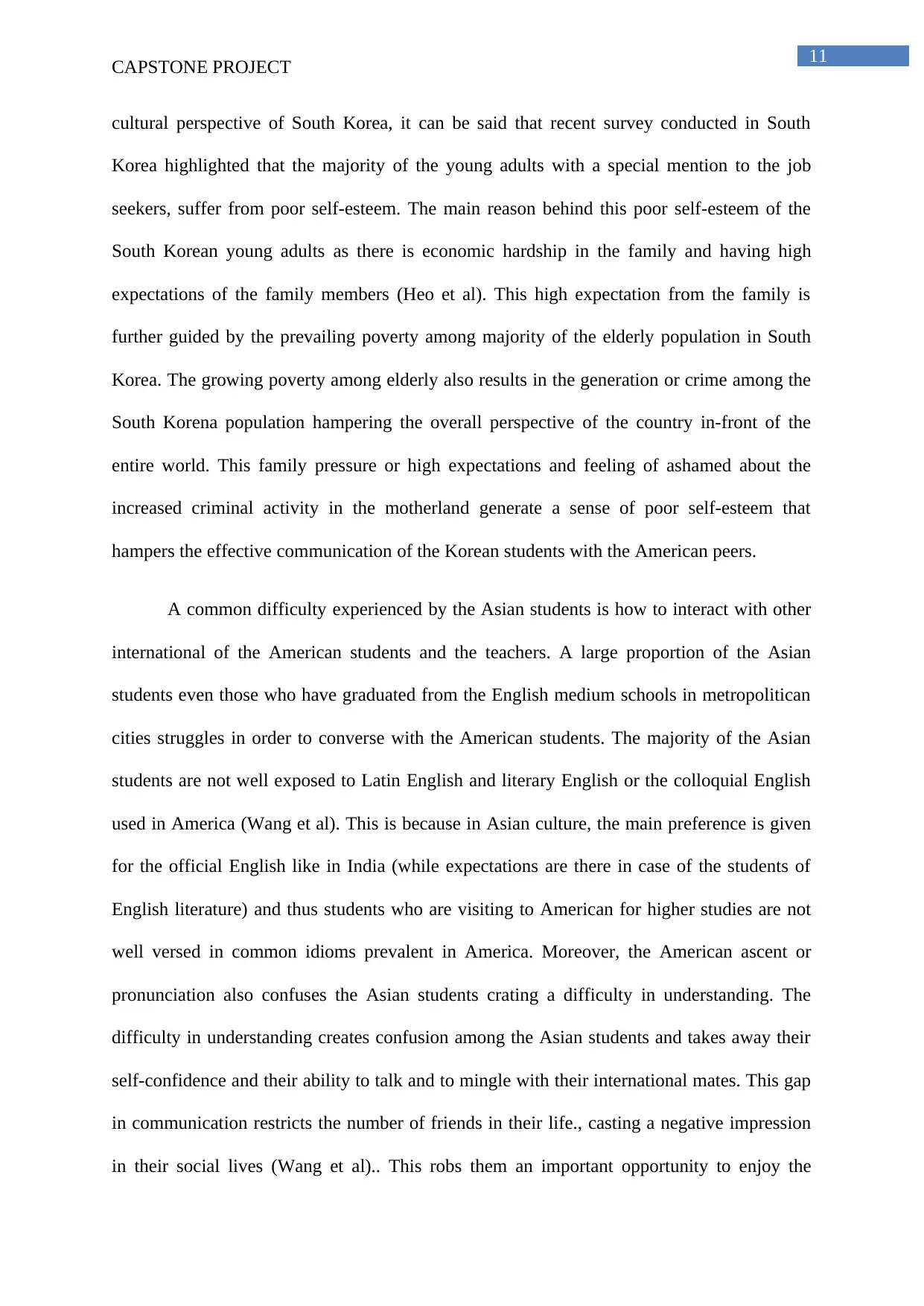
11
CAPSTONE PROJECT
cultural perspective of South Korea, it can be said that recent survey conducted in South
Korea highlighted that the majority of the young adults with a special mention to the job
seekers, suffer from poor self-esteem. The main reason behind this poor self-esteem of the
South Korean young adults as there is economic hardship in the family and having high
expectations of the family members (Heo et al). This high expectation from the family is
further guided by the prevailing poverty among majority of the elderly population in South
Korea. The growing poverty among elderly also results in the generation or crime among the
South Korena population hampering the overall perspective of the country in-front of the
entire world. This family pressure or high expectations and feeling of ashamed about the
increased criminal activity in the motherland generate a sense of poor self-esteem that
hampers the effective communication of the Korean students with the American peers.
A common difficulty experienced by the Asian students is how to interact with other
international of the American students and the teachers. A large proportion of the Asian
students even those who have graduated from the English medium schools in metropolitican
cities struggles in order to converse with the American students. The majority of the Asian
students are not well exposed to Latin English and literary English or the colloquial English
used in America (Wang et al). This is because in Asian culture, the main preference is given
for the official English like in India (while expectations are there in case of the students of
English literature) and thus students who are visiting to American for higher studies are not
well versed in common idioms prevalent in America. Moreover, the American ascent or
pronunciation also confuses the Asian students crating a difficulty in understanding. The
difficulty in understanding creates confusion among the Asian students and takes away their
self-confidence and their ability to talk and to mingle with their international mates. This gap
in communication restricts the number of friends in their life., casting a negative impression
in their social lives (Wang et al).. This robs them an important opportunity to enjoy the
CAPSTONE PROJECT
cultural perspective of South Korea, it can be said that recent survey conducted in South
Korea highlighted that the majority of the young adults with a special mention to the job
seekers, suffer from poor self-esteem. The main reason behind this poor self-esteem of the
South Korean young adults as there is economic hardship in the family and having high
expectations of the family members (Heo et al). This high expectation from the family is
further guided by the prevailing poverty among majority of the elderly population in South
Korea. The growing poverty among elderly also results in the generation or crime among the
South Korena population hampering the overall perspective of the country in-front of the
entire world. This family pressure or high expectations and feeling of ashamed about the
increased criminal activity in the motherland generate a sense of poor self-esteem that
hampers the effective communication of the Korean students with the American peers.
A common difficulty experienced by the Asian students is how to interact with other
international of the American students and the teachers. A large proportion of the Asian
students even those who have graduated from the English medium schools in metropolitican
cities struggles in order to converse with the American students. The majority of the Asian
students are not well exposed to Latin English and literary English or the colloquial English
used in America (Wang et al). This is because in Asian culture, the main preference is given
for the official English like in India (while expectations are there in case of the students of
English literature) and thus students who are visiting to American for higher studies are not
well versed in common idioms prevalent in America. Moreover, the American ascent or
pronunciation also confuses the Asian students crating a difficulty in understanding. The
difficulty in understanding creates confusion among the Asian students and takes away their
self-confidence and their ability to talk and to mingle with their international mates. This gap
in communication restricts the number of friends in their life., casting a negative impression
in their social lives (Wang et al).. This robs them an important opportunity to enjoy the
⊘ This is a preview!⊘
Do you want full access?
Subscribe today to unlock all pages.

Trusted by 1+ million students worldwide
1 out of 30
Related Documents
Your All-in-One AI-Powered Toolkit for Academic Success.
+13062052269
info@desklib.com
Available 24*7 on WhatsApp / Email
![[object Object]](/_next/static/media/star-bottom.7253800d.svg)
Unlock your academic potential
Copyright © 2020–2025 A2Z Services. All Rights Reserved. Developed and managed by ZUCOL.




